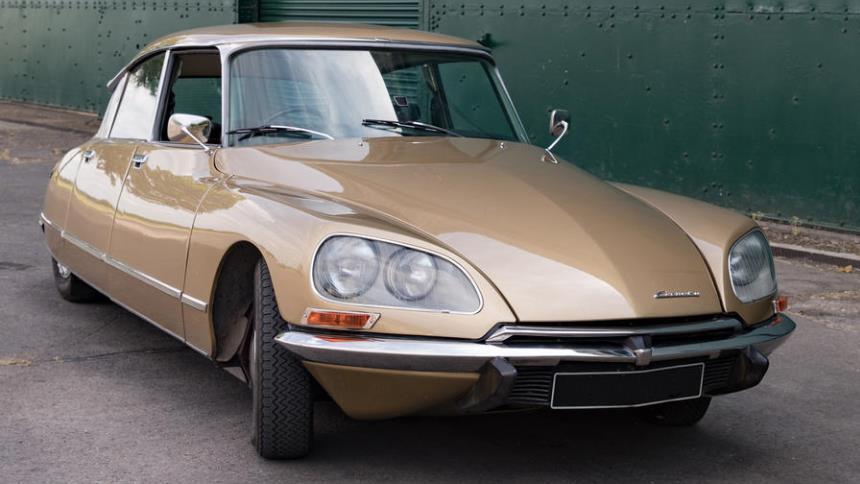
Citroen DS - From space? From the sky? definitely not of this world
There was a time in the history of the automotive industry when philosophers compared cars to Gothic cathedrals, when cars were works of art, and their unique design forever witnessed the era, people and achievements of civilization. Was there such a car? Citroen DS.
space direction
In the cold autumn of 1955, Citroen gave Parisians a journey into the future. The presentation of the new car was scheduled for October - it was supposed to be the successor to the Traction Avant model, respected on the Seine, so high expectations were natural. But the DS didn't look like a car, because cars didn't look like that back then. It was different, incomparable, innovative, dropped from space onto the French capital, like the Eiffel Tower more than half a century ago. That day, stunned spectators at the Paris Motor Show unleashed an avalanche of 12 orders on Citroen. Everyone wanted this car because it felt absolutely unique. Looking for an analogy in this general madness, we can say that in the fall of the year DS was today's iPhone, especially during the years of its debut on the market.
To better understand the appearance of the Citroen DS, you need to take a broader look at the atmosphere that prevailed at that time in Europe and the world. The post-war tension that pulsed between the United States and the Soviet Union was soon to spread beyond our planet. In 1955, mankind was on the threshold of the space age, the era of the space arms race between the two greatest powers. But long before the Russians launched a satellite into orbit, the passion for conquering and exploring the universe was reflected in various areas of human culture and civilization: from books, films and music to fashion, useful design, architecture and automotive engineering. "Space Age" in the design of the 50-60s. fit perfectly into the flourishing post-war modernism.
contemporary sculpture
Without dreams of conquering space, the DS would probably be a completely different car, maybe just as avant-garde, but without all this otherworldly shell. It is worth remembering how the most famous Citroen model was created. In the age of star exploration, DS designer Italian artist Flaminio Bertoni simply sculpted his silhouette. As in antiquity. There were no computers, no simulations - before the car was dressed in sheet metal, it was a sculpture.
The work of Citroen is not only an outstanding style. It is also a whole revolutionary technology and design, for which the brilliant André Lefebvre, an engineer and former aircraft manufacturer, was responsible. Few people owe Citroen as much as he does - Lefebvre created the most important models of the brand: in addition to the DS, also the 2CV, as well as the Traction Avant and HY. And yet, Citroen's main competitor was close to taking advantage of the ideas of this excellent designer. Before Lefebvre joined him, he worked for Renault for two years.
Work on the DS lasted more than a dozen years and began even before the Great Patriotic War. The final effect was as dazzling as the body polished by Bertoni: above all, the hydropneumatic suspension that immediately made the Citroen the most comfortable sedan in the world. The driver could adjust the ground clearance of the car - from 16 to 28 centimeters, which, taking into account the state of the French roads of that time (especially the distance from Paris), was not only an effective solution, but also extremely effective. The suspension design made it possible to ride even on three wheels. In addition, the ubiquitous hydraulics responsible for managing the four disc brakes, power steering, clutch and gearbox. Going further: cornering headlights - something like this was reserved only for the most luxurious cars of the upper segment until a few years ago. DS has also been a pioneer in terms of safety (controlled crush zone) and the use of lightweight materials (aluminum and plastic).
Charles de Gaulle, President of France, saw how reliable this car was. When an attack was organized on the outskirts of Paris in 1962, and his DS was fired upon from a firearm (one of the bullets passed a few centimeters from de Gaulle's face, the car was not armored), despite the punctured tires, the driver managed to escape at full speed. speed.
goddess reincarnation
DS was produced for 20 years. During this time, the car found as many as 1,5 million buyers, despite the fact that Citroen did not have time to promote its work in the United States (a total of 38 copies were sold in the United States). Oddly enough, in the country that most loved the “space age” style, the DS was considered a curiosity, and too small to meet the requirements that Americans place on comfortable limousines. In Europe, the cheaper, we would say today - budget version of the car called ID was also very popular. There were also, among others, a station wagon (based on the ID), a convertible (the rarest of the DS, produced from 1958 to 1973; only about 2 units of this model were produced), a quite successful rally car and the most luxurious version of the Pallas. During the year, the car underwent the only major stylistic change - the round headlights were hidden in the lampshades, and the nose of the car was redesigned.
The French, otherwise very carefully, nicknamed the DS "déesse", which means "goddess" (female car in French). The French philosopher Roland Barthes dedicated several phrases to this goddess in his Mythologies (1957): “I think that today's cars are the true equivalent of the great Gothic cathedrals. That is, the greatest representatives of our era. Clearly, this new Citroen has fallen from the sky.
The DS era ended in 1975. The new Citroen opened with a no less bold, no less comfortable, but much less technologically advanced CX model. The legend of the car sent from heaven went to the museum. Citroen remembered this when, in 2009, it opened its new top-of-the-line lineup, in the nomenclature of which it used the immortal two letters. And then it was decided to take the next step - to create a new prestigious brand called DS. It would be at least blasphemous if Citroën did not take advantage of the inspiration flowing from the most outstanding automotive work that he managed to compose when creating it.
